In the swiftly evolving digital era, technology stands as a cornerstone for the growth and sustainability of small businesses. The integration of innovative technological solutions enables enterprises to enhance operations, improve customer engagement, and remain competitive. Small businesses are leveraging an array of technologies — from cloud computing to artificial intelligence (AI) — not only to automate and streamline processes but also to gain valuable insights that help in making more informed decisions.
Evaluating Your Current Technology Stance
Assessing the current technology utilised by a business is crucial to maintaining competitiveness and efficiency. The first step is to inventory your existing technologies. This includes hardware, software, and any digital platforms that the company relies on. By cataloguing these tools, businesses gain a clearer picture of their capabilities and identify areas where upgrades may be necessary.
With an inventory in hand, it becomes important to analyse how these technologies impact data management. Effective data analysis and reporting can lead to improved decision-making and is a key area where technology should aid a business. One should evaluate if the existing tools provide the necessary insights and whether they integrate well with other systems used by the company.
Another critical aspect is determining the efficiency gains from the current technology stack. It’s essential to ask: are these technologies optimising business operations? Indicators of inefficiency could include repetitive manual tasks that could be automated, slow processing times, or frequent system downtimes.
Moreover, technology should align with the business’s strategic objectives. For instance, if a company’s goal is to become more sustainable, incorporating eco-friendly technologies, such as those offered by Capcon Engineering, specialists in rainwater drainage systems, can be a forward-thinking move that supports both efficiency and environmental goals.
Ultimately, taking a thorough and critical look at your current technology stance paves the way for making informed decisions on future investments. It’s by understanding the gaps and recognising the strengths of your existing landscape that a business can progress and adapt to the evolving technological world.
Strategic Planning for Digital Transformation
Staying ahead in today’s market requires small businesses to embrace digital transformation with a strategic approach, ensuring every technological upgrade aligns with their long-term business objectives.
Setting Clear Goals for Transformation
For small businesses, the initial step in strategic planning for digital transformation is to establish clear, measurable goals. These objectives should outline what the business wishes to achieve through digitisation, such as improving customer experience or streamlining operations. For example, a retail business might aim to increase online sales by 20% within the first year post transformation.
Aligning Technology with Business Strategy
To successfully integrate digital solutions, businesses must align new technologies with their overall business strategy. This includes not only identifying the right tools and platforms that match the business’s need but also ensuring that there is a synergy between these digital solutions and the existing business processes. Crucially, this strategic alignment often requires careful financial planning for business owners, as investments in technology should be mapped against expected returns and cost savings.
By adopting a structured approach to setting transformation objectives and selecting technologies that support the overarching business strategy, small businesses can effectively navigate the digital landscape.
Optimising Business Operations with Technology
Integrating technology into business operations can markedly increase efficiency and streamline processes. For instance, automation serves to reduce human error, allowing small businesses to dedicate more time to strategic tasks. Tools like customer relationship management (CRM) systems can automate client communications and sales reporting, providing a clear view of business performance.
Data analytics plays a pivotal role in understanding customer behaviour and market trends. By harnessing this power, businesses make informed decisions, tailor their marketing strategies, and ultimately heighten productivity. Small businesses may employ analytics to monitor their supply chains, which can lead to reduced costs and improved delivery times.
Furthermore, adopting collaboration tools has become essential. These platforms enable seamless communication between team members who may be working remotely or in different parts of the world. Features like file sharing, real-time editing, and video conferencing boost team productivity.
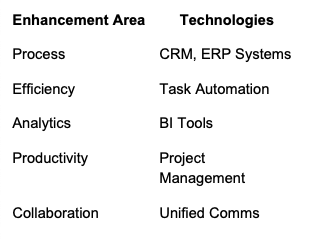
Investment in the right technology enables small businesses to compete with larger enterprises by maximising resources and responding swiftly to market shifts. By implementing these strategic technologies, businesses can expect a robust return on investment through increased operational efficiency and improved overall performance.
Building a Robust Online Presence
In today’s digital age, a small business must harness various technology strategies to cultivate a prominent online presence. A well-designed website serves as the cornerstone of this presence. It should not only reflect the brand’s identity but also be mobile-responsive to cater to users on-the-go.
Search Engine Optimisation (SEO) is essential to increase visibility. Techniques such as keyword research and on-page optimisation ensure that a website ranks higher in search engine results, making it more accessible to potential customers.
Social media is another pivotal component. Small businesses can engage directly with their audience on platforms where their customers are most active. Regular updates and interactive content foster community and keep the brand at the forefront of consumer minds.
Adding a blog to the business website can drive traffic and improve SEO efforts. Informative and relevant blog posts position a business as a thought leader in its niche, improving trust and credibility.
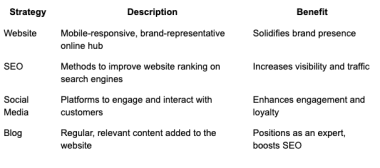
By integrating these strategies, small businesses can establish a robust online presence, essential for success in the digital marketplace. Each component works together to create a cohesive and effective online footprint, reaching customers where they spend a significant amount of time: online.
Enhancing Customer Experience and Service
Businesses can enhance customer experience (CX) by incorporating technology that affords seamless interactions and personalised service. A customer relationship management (CRM) system proves instrumental by providing a central repository for customer information, which enables tailored communications and services.
Interactive features like live chat can offer immediate assistance, elevating the user experience and satisfaction levels. Live chat technology contributes to service efficiency and can answer customer queries promptly. Its integration presents a direct communication channel, which customers have come to expect as standard service.
Customer feedback is vital. Employing technology that systematically collects and analyses feedback empowers businesses to make informed decisions and adapt to consumer needs. This data, gathered through various digital touchpoints, can lead to continuous improvement of services and products.
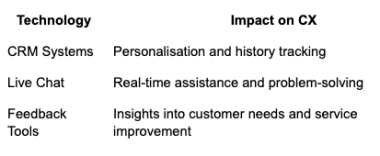
User experience is enhanced when technology is used to streamline processes and reduce friction points. For instance, using automated processes for frequently asked questions can filter out simple queries and allow customer service representatives to focus on more complex issues.
Incorporating technology into customer service isn’t simply about keeping pace with digital trends—it’s an investment in the business’s relationship with its customers. When executed well, the blend of technology and human attention leads to more robust customer relationships and fosters loyalty, which is paramount for business success.
Exploiting Marketing Technologies for Growth
In the digital age, small businesses can leverage a variety of marketing technologies to fuel their growth. The key lies in selecting the right tools to enhance customer engagement and streamline marketing efforts.
Email Marketing
Firstly, email marketing remains a potent tool for reaching customers directly. Businesses can utilise automated email campaigns to deliver personalised content, thus driving both engagement and conversion rates. Email marketing platforms offer analytics to track open rates, click-throughs, and overall campaign performance, enabling businesses to refine their strategies.
Social Media Platforms
Social media platforms serve as vital channels for brand visibility and interaction. They allow businesses to:
- Build brand awareness
- Engage in real-time conversations
- Receive customer feedback
- Run targeted advertisements
Targeted social media ads can significantly increase the likelihood of reaching the intended audience, leading to increased website traffic and potential sales.
Customer Relationship Management
Integrating Customer Relationship Management (CRM) systems enables businesses to maintain detailed profiles of their customers. This data is critical for tailoring marketing messages and offers to match consumer preferences and behaviours.
Analytics and Data-Driven Strategies
Companies should employ analytics tools to gain insights into customer journeys across various touchpoints. This information can guide decisions on where to allocate resources for the maximum impact.
By adopting technological solutions in marketing, businesses can achieve a higher return on investment, driving sustainable growth in a competitive landscape. The key is to maintain agility, continuously adapting to emerging tools and platforms that can give a company the edge in reaching its target market.
Fostering Collaboration and Communication
Effective collaboration and communication are fundamental to any small business’s success. Creating a culture that emphasises open dialogue and teamwork can significantly enhance productivity and innovation. Communication should be transparent and facilitate a two-way exchange of ideas, particularly to align with the company’s vision.
One should invest in collaboration tools which enable teams to stay connected regardless of location. Tools like instant messaging, video conferencing, and real-time document editing can break down traditional barriers, allowing for a more dynamic work environment.
To foster a collaborative culture, small businesses ought to:
- Encourage feedback, ensuring that all voices are heard.
- Promote trust, thereby reducing fear and mistrust.
Here are some tips for enhancing communication and collaboration:
By consistently applying these strategies, a small business can create a robust framework for collaboration and communication, essential for navigating the complexities of today’s business landscape.
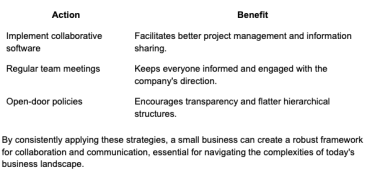
Leveraging Financial Technologies for Efficiency
Incorporating the right financial technologies significantly streamlines accounting processes and enhances the efficiency of transactions, driving revenue and profit growth for small businesses.
Streamlining Accounting with Software
Small businesses should consider the critical step of streamlining their accounting with sophisticated software tools. For instance, setting up Xero as an accounting platform empowers businesses to automate their financial tracking, simplifying tasks such as invoicing, payroll, and tax calculations. Results can include more accurate financial records, better compliance, and a clearer understanding of their financial health.
Facilitating Payments and Sales with POS Systems
Efficiently facilitating payments and sales is paramount for customer satisfaction and revenue management. Modern POS systems, tailored to a business’s specific needs, can dramatically enhance transaction speed and accuracy. By handling sales, tracking inventory, and even generating analytical sales reports, these systems contribute to a more robust bottom line.
Navigating the Logistics and Supply Chain with Tech
The integration of technology into logistics and supply chain operations has revolutionised how small businesses manage inventory, enhance efficiency, and interact with vendors. Inventory management systems now utilise sophisticated algorithms to forecast demand, automate reordering, and balance stock levels, mitigating the risk of overstocking or stockouts.
Supply chain visibility is another area where technology plays a pivotal role. Real-time tracking solutions provide businesses with instant updates, improving the transparency of shipments and inventory flow. This information is crucial for small businesses to adapt quickly to any disruptions and maintain continuity.
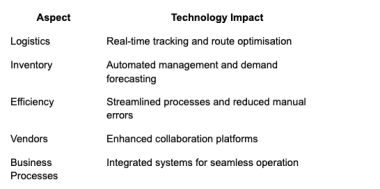
Communication with vendors has also been enhanced through tech, with platforms that allow for seamless exchange of information and faster decision-making. This leads to stronger relationships and more reliable supply chains.
In terms of business processes, technology has proved indispensable. Integrated systems allow for a single source of truth, ensuring that every part of the supply chain is accurately and consistently informed, from warehouses to customer delivery points.
For small businesses looking to remain competitive, investing in the right technological tools is crucial. By focusing on technologies that optimise logistics and supply chain management, small businesses can achieve a level of efficiency and resilience that was once only possible for larger corporations.
Ensuring Security and Compliance
In today’s digital landscape, small business owners must adopt effective technology strategies to protect sensitive data and adhere to regulatory requirements.
Safeguarding Data with Robust Cybersecurity Measures
For small businesses, the safety of digital data is paramount. Implementing robust cybersecurity measures is essential in protecting against cyber threats. A comprehensive strategy includes the deployment of sophisticated anti-malware software, regular software updates to thwart vulnerabilities, and utilisation of firewalls to control incoming and outgoing network traffic. Additionally, small businesses should consider using CCTV systems, which have become more affordable and significantly contribute to the overall security infrastructure.
- Data Encryption: Encrypt sensitive information to protect it from unwanted access.
- Employee Training: Conduct regular sessions on cybersecurity best practices.
Maintaining Compliance with Regulations
Compliance with relevant regulations is a legal necessity for small businesses. Staying up-to-date with the latest compliance requirements can be a complex task, but it is one that cannot be ignored due to the legal and financial implications of non-compliance. To ensure adherence, small businesses should:
- Conduct Regular Audits: Regularly review processes to align with current regulations.
- Automate Compliance Tasks: Leverage tools for automation of compliance which streamline documentation and reporting. Small businesses should make this a priority to mitigate risks associated with keeping data safe and adhering to legal standards.
Written by Michael Deane











